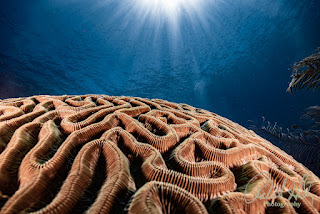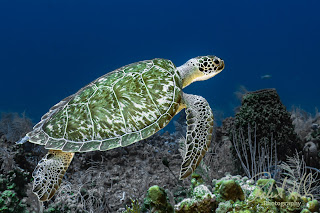Mastering the New 'Select Water' AI Mask in Lightroom (v14.4)
Mastering the New 'Select Water' AI Mask in Lightroom (v14.4): Another Game-Changer for Underwater Photography
📍 Dive deeper every week at info.robertherb.com/lm-2-blog
Have you ever captured the perfect angle of a manta ray or reef shark, only to find that the background water looks lifeless, grey, or murky? Suppose you've ever struggled with enhancing blue water or separating your subject from a cluttered ocean backdrop. In that case, Lightroom Classic's newest AI-powered Select Water mask — introduced in version 14.4 - is precisely the tool you've been waiting for.
This fantastic new feature is specially designed with underwater photographers in mind. Whether you're shooting in the crystal-clear waters of the Caribbean, navigating through murky mangroves, or even working in a chlorinated training pool, Select Water intelligently isolates water backgrounds to make your editing process faster, easier, and much more precise than ever before. For example, suppose you're photographing a school of colorful fish in a tropical lagoon. In that case, this tool can help you easily separate the water from your subjects, making the colors pop without the distraction of murky or dull water in the background.
🧠 Why "Select Water" Matters for Oceanic Explorers
Before this recent update, isolating water areas in your photos could be quite a tedious task, often requiring manual brushing or the use of radial filters to achieve the desired effect. These methods could be time-consuming and sometimes challenging, especially with complex compositions. Now, thanks to Lightroom's latest AI technology, there's a much easier way. With just one click, Lightroom can intelligently detect and create a mask for the entire water body within your frame, even if the scene is crowded with details like fish, coral, or divers, making the masking process much simpler and more accurate.
This new feature enables us to apply local adjustments, such as enhancing Clarity, fine-tuning color grading, or reducing noise, specifically to the background water. This way, we can improve the water's appearance without inadvertently harming the subjects within it, such as fish or coral, thereby ensuring a natural and polished look. To help you make the most of this exciting update, let's explore five underwater-specific workflows where this powerful new masking feature can significantly boost your editing efficiency and creativity.
🌊 Example 1: Enhancing Bluewater Behind a School of Fish
Use case: Clear water shot, fish centered in the mid-frame, but the background water appears dull.
Step-by-step:
-
Press D to open the Develop Module
-
Press Shift + W to open the Masking Panel
-
Click Create New Mask → Select Water
Lightroom AI instantly masks all visible water in the background.
-
Adjust the Temp slider to slightly shift cooler (e.g., -5 to -10)
-
Increase Clarity (+20) to give the water more structure
-
Lower Saturation if blues are too intense, or boost it (+10–15) for tropical vibrance
🎯 Keyboard Shortcuts Recap:
-
Develop Module:
D -
Open Masking:
Shift + W -
Enable/Disable Mask Overlay:
O
🐠 Example 2: Separating a Fish from Murky Water
Use case: A vibrant angelfish against a hazy green water background
Step-by-step:
-
Create two masks:
-
First: Select Subject (fish)
-
Second: Select Water
-
-
On the Select Water mask:
-
Increase Dehaze (+20 to +30) to cut through the murk
-
Lower Exposure slightly (–0.20)
-
Add Noise Reduction (+30) to reduce distracting background artifacts
-
-
On the Select Subject mask:
-
Boost Texture and Clarity (+20 each) to make the fish pop
-
💡 This dual-mask approach ensures your subject stays sharp while the background stays clean and subtle.
🐬 Example 3: Dolphin in Shallow Ocean with Background Enhancement
Use case: A dolphin framed mid-column in bright, shallow water, the background lacks color contrast
Workflow:
-
Click Shift + W to open the Masking Panel
-
Use Select Water to isolate the bright background water
-
Adjust sliders to create tonal depth:
-
Temp: –8 (for a cooler tropical look)
-
Clarity: +25
-
Vibrance: +20
-
Dehaze: +10 (for subtle water texture)
-
-
Create a second mask using Select Subject on the dolphin and boost Exposure slightly (+0.20) to emphasize movement and direction
🌊 This brings depth and vibrancy back into the water column while keeping the animal crisp and naturally lit.
🌫️ Example 4: Murky Ocean Background with a Silhouette Subject
Use case: A diver silhouetted near the surface with backscatter-heavy, grey-green water below
Step-by-step:
-
Select Water to isolate the hazy background
-
Lower Contrast slightly (–15 to –20) to reduce harshness
-
Increase Dehaze (+30 to +40) to cut through the silty appearance
-
Add Noise Reduction (+50) for smoother gradients
-
Use Color Grading (Midtones or Shadows) to subtly reintroduce blue/cyan tones
-
Then, use Select Subject to mask the silhouette:
-
Leave it unaltered for a dramatic cut-out look
-
Or drop Exposure (–0.30) slightly for a cleaner outline
-
🎯 Press K to activate the Brush Tool if you need to clean up mask bleed around the diver's limbs or tank.
💡 Bonus Tip: In dense water conditions, even minor adjustments can bring atmosphere back into the frame without artificial overprocessing.
🚢 Example 5: Blue Background Balance in Wreck Photography
Use case: Ambient light illuminating the water outside a wreck's window or opening
-
Zoom in on the wreck interior using Shift + Space
-
Select Water to mask the background glow through the wreck's open spaces
-
Apply a slight Vignette using Radial Filter (Shift + M) around the window for cinematic contrast
-
Adjust the Water Mask:
-
Add Temp –10, Clarity +25, Noise Reduction +40
-
This draws the eye through the wreck's interior toward a rich blue exit, a dramatic storytelling effect.
✨ Bonus: Lightroom Mobile Tip
On Lightroom Mobile (v9.4+), "Select Water" is just as effective. I often test this feature during surface intervals on my Android Tablet. Tap the Masking icon, select Water, and refine tones just as you would in Lightroom Classic.
It's like bringing the power of your desktop underwater, without having to lug the laptop.
🖱️ Final Thoughts: What You Used to Brush, You Now Mask in Seconds
With the release of v14.4, Select Water fills a long-standing gap for underwater editors. You no longer need to fight global sliders or manually outline water zones. AI does the heavy lifting—your job is simply to guide the creative vision.
Whether you're cleaning up a backscatter-filled cave dive or amplifying that perfect Bahamian blue, this tool adapts beautifully to the needs of Oceanic Explorers like us.
🧭 What's Next?
🟦 Have you tried the new Select Water tool yet? Share your edits using #RobertHerbPhotography.
🟦 Want to see these workflows in action? Sign up for my upcoming training course at RobertHerb.com or reach out at bob@robertherb.com
🟦 And don't forget—new blogs drop weekly at: info.robertherb.com/lm-2-blog
Until next time… dive deep, shoot smart, and let Lightroom bring your vision to the surface.
– Bob Herb
Robert Herb Photography
Empowering Underwater Photographers Since 1978
Written by Robert Herb – Empowering underwater photographers to capture and enhance the beauty of our oceans.
Stay tuned for more in-depth insights into underwater photography. Let's dive deeper into the art and craft of capturing the marine world! If you have any comments or suggestions, I'd love to hear them.
Get ready for an exciting underwater photography adventure! For more details on my upcoming online training course, check out my "Training" page at RobertHerb.com or email me at bob@robertherb.com.
Sincerely,
Bob Herb
|
|





Comments
Post a Comment
Please let me know your comments.